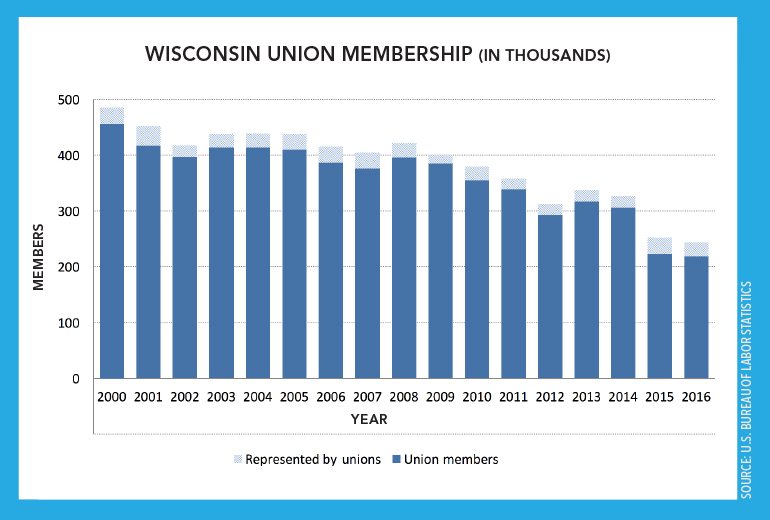Ross Winklbauer got a phone call recently from a young man who felt he and his co-workers needed union representation. The man said the company wasn’t treating them well and he hoped to change things.
When he asked the man which company he was talking about, Winklbauer, a sub-district director with the United Steelworkers, recognized it. The USW had represented about five employees out of 70 there up until a few years ago.

“We ended up having to unfortunately walk away,” Winklbauer said.
The caller, it turned out, had worked at the company for about a decade but was never a union member because he didn’t see the need.
“It was too many people like you that thought, ‘Why do I need a union? This company will treat me right,’” Winklbauer told the man, adding he would need to have at least 90 percent of the employees on board before they could talk.
Union membership nationally has been trending down for decades and the declines have only accelerated in Wisconsin over the past several years. From 2000 to 2010, Wisconsin averaged an annual drop of 10,000 union members. Since 2011, the average yearly decline has been more than 22,000, including a drop of 83,000 from 2014 to 2015, when right-to-work became law.
“If you solely look at the numbers, it’s depressing,” Winklbauer said. “But when you look at the activism that’s going around and the people we’re getting involved … once they start seeing the benefits and understand the benefits, we’ll be around.”
With Gov. Scott Walker and Republicans in control of state government since 2011, there haven’t been many legislative victories for unions to celebrate. Act 10, the law eliminating most collective bargaining for public unions, drew tens of thousands of protestors to Madison, but Walker ultimately won the related 2012 recall election. A Dane County judge put right-to-work on hold, but an appellate court stayed the ruling and ultimately sided with the state. The latest state budget repealed prevailing wage, which set compensation on state construction projects, and Walker used his veto pen to make it effective immediately.
Act 10 was directed at public sector unions and Ken Kraemer, executive director of Building Advantage, a nonprofit that promotes the hiring of union construction contractors and tradespeople, pointed out prevailing wage will affect union and non-union workers, but right-to-work has the biggest potential to weaken private sector unions over the longer term.
“It takes numbers to make things happen and companies watch,” Winklbauer said.
In Wisconsin, there’s been only one work stoppage involving more than 1,000 workers in the past five years. The month-long strike at Kohler Co. in 2015 included 2,100 workers in Sheboygan County. It ended with a narrower difference in pay for employees in different tiers, wage increases in each year of the contract and improved benefits.
“It was a lot of moral things,” Tim Tayloe, president of United Auto Workers Local 833, said of the reason for the strike, pointing in particular to wages around $10 per hour for some workers.
The contract ending the strike was “a very good outcome,” the company and union are working well together and membership is growing, he said. Only a few workers have opted out of the union following the passage of right-to-work.
“We are holding very strong,” Tayloe said.
Essentially, the right-to-work law prohibits companies from mandating union membership as a condition of employment. In challenging the law, unions argued right-to-work amounted to an unconstitutional taking of their property. The unions are required to represent non-members but cannot compel them to pay dues. A Dane County judge accepted that argument, but the state appeals court overturned it earlier this year.
In another case, the exact timing of when a contract was ratified, whether it was before or after right-to-work took effect, has led to a legal challenge. Ten employees, helped by the National Right to Work Legal Defense Foundation, sued Allenton-based metal fabricator Maysteel Industries LLC and the International Association of Machinists District 10, arguing the contract was signed after the law went into effect and they can no longer be forced to be union members. That case is still pending in the U.S. District Court for the Eastern District of Wisconsin.
Changing contracts
In theory, bringing union contracts in line with the right-to-work law only requires deleting language that requires union membership for employment when the contract comes up for negotiation. In practice, however, it weakens the union’s position and opens up the door to other changes.
“The biggest thing we’re seeing now is companies, during negotiations, want to attack us. They’re like sharks with a little blood in the water,” Winklbauer said.

Jon Anderson, managing partner of law firm Godfrey and Kahn S.C.’s Madison office, said in some cases companies have been able to parlay their stronger position into some concessions, but in others there are longstanding relationships that companies don’t want to hurt.
“I’m not sure every employer was in favor of right-to-work as a concept,” said Anderson, an attorney who frequently represents companies in labor negotiations. “Others welcomed it with open arms.”
Rich Meeusen, chairman, president and chief executive officer of Brown Deer-based water meter manufacturer Badger Meter Inc., was among those making the case for right-to-work.
“From a moral perspective, I like the idea that my employees have a choice,” Meeusen said, arguing right-to-work results in a more content workforce.
“A union can bring good things, because they can bring structure, but they can also bring difficulties,” he added, pointing to additional layers of bureaucracy.
Badger Meter is also among the companies that have negotiated new contracts since right-to-work was passed. Meeusen said negotiations were not dramatically different than in the past. The company did not try to squeeze something out of the union, he said, but added Badger Meter did ask for things like not automatically enrolling new members and not deducting union dues from paychecks.
“I think that’s very reasonable,” he said.
Dues collection is one of the areas in which Winklbauer said companies are seeking concessions, “even though it has nothing to do with right-to-work.”
Right-to-work also increases the possibility of a non-union member receiving the benefits of a union without paying. In 2015, there were 30,000 more workers in Wisconsin represented by unions than there were union members, an increase of 9,000 from the previous year, according to the Bureau of Labor Statistics.
Anderson said the possibility of “free loaders” can cause issues for employers who want a workforce focused on the company’s mission.
“That’s a very real issue for unions and it creates friction among employees and that’s not good for the employer,” he said.
Anderson said right-to-work has prompted unions “to sell their services” and “to be out there justifying to members and potential members.”
Winklbauer said a union local lost seven
members in one of the first contracts he negotiated after right-to-work became law. It was a wake-up call for the local, but the departures didn’t turn into a trend for other unions.
“As far as our membership goes, we’ve held our numbers since right-to-work came in,” Winklbauer said.
There are examples of the United Steelworkers adding members. Wauwatosa-based Briggs & Stratton Corp. went from 395 local union employees in 2013 to 510 this year, and Glendale-based Strattec Security Corp. is up 59 members, to 275, since 2011.
Badger Meter’s union workforce at its Brown Deer headquarters, on the other hand, is down 17 percent since 2011. When right-to-work was being debated, Meeusen said passing the law could make the difference between Badger Meter sending work to Mexico or bringing it to Wisconsin.
The bill signing ceremony took place at Badger Meter, and Meeusen said the company has since added 30 to 40 positions between its Brown Deer and Racine facilities. The jobs have included machining, welding and painting work previously done by outside vendors.
Badger Meter is also planning to close its Scottsdale, Arizona facility and move about 35 jobs to Racine by March. The 32,000-square-foot facility has a National Institute of Standards and Technology-certified lab and provides precision machining and advanced assembly for the company.
“Frankly, we would not have been doing all of that if Wisconsin were not a right-to-work state,” Meeusen said, adding the move might still have taken place, but the work would have gone elsewhere.
Business backs right-to-work
Right-to-work proponents argue passing the law makes Wisconsin more attractive to companies considering relocating to the state.
“It’s a really important box that we need to be able to check in order to secure bigger projects,” said Jim Paetsch, vice president for corporate relocation, expansion and attraction at the Milwaukee 7 regional economic development partnership.

Paetsch added companies are looking at more than cost and in many cases, not having right-to-work will remove a state from consideration.
“They’re looking, probably more importantly, at risk,” he said. “Unionized environments create uncertainty for employers.”
In the 2016 Area Development magazine corporate executive survey, about 70 percent of respondents said both a low union profile and right-to-work were either important or very important site selection factors. Highway accessibility, availability of skilled labor and labor costs were the top factors.
Paetsch said a number of factors went into Wisconsin landing the new U.S. facilities planned by Foxconn Technology Group and Haribo of America, but right-to-work was certainly a factor.
Foxconn’s contract with the state, which sets up $3 billion in incentives in exchange for a $10 billion investment and 13,000 jobs, includes language that exempts the company from default in the event of an unlawful work stoppage or strike. The language isn’t in other Wisconsin Economic Development Corp. contracts and spokesman Mark Maley said it was part of negotiations.
Beyond the major projects, Scott Manley, senior vice president of government relations at statewide chamber Wisconsin Manufacturers and Commerce, said right-to-work states generally have net in-migration and the law could help reverse Wisconsin’s trend of losing residents.
“We believe Wisconsin will become a magnet for talent and that’s incredibly important for employers,” he said.

Manley said the current labor market already favors those looking for work, and having right-to-work removes a potential barrier some employers faced in trying to hire.
“If I’m a skilled worker, I can command a high wage and I don’t need a union in order to command a high wage,” he said, suggesting the prospect of part of a paycheck going to union dues was a deterrent for some.
While union leaders say their membership is holding and they are working hard to demonstrate their value, Manley said some WMC members have seen a significant drop in those choosing to pay dues and others opting to decertify.
“It’s still early,” he said, adding many unions may not have had to renew a contract with right-to-work as the law.
Union popularity rising
At the same time that companies are looking to move to right-to-work states, unions are seeing a resurgence in positive public perception, returning to levels last seen before the Great Recession.
A Pew Research Center poll in January found 60 percent of respondents held a favorable view of unions, up from 48 percent in March 2015. Gallup has found similar trends, with 61 percent approving of unions in an August poll.
“For a while there it seemed like saying you were in a union, people looked at you like, ‘Why?’” Kraemer said.
He added the coverage of Act 10 and right-to-work helped shift attitudes against unions, but with the number of jobs available, especially in construction, views are swinging back.
“I know that we’ve always been proud to say that we’re union,” Kraemer said, adding it has become easier to talk to parents about health and retirement benefits available for their children in union construction, especially as college costs increase. “I think the mindset has changed a little bit.”
Winklbauer suggested changing corporate and business cultures are contributing to the attitude shift. He said in the past a company owner or president would come out on the shop floor and know employees’ names and talk with them.
“They treated you decent, they treated you with respect, both union and management, and you felt good about the company you worked for,” Winklbauer said. “Today, in a lot of cases, unfortunately, that has gone by the wayside.”
He added people are realizing “how much they need a union” and union members are also realizing the importance of the support they have.
“A lot of the people are seeing, through contract negotiations, what the companies are trying to do to them,” Winklbauer said. “If they’re doing this to us now with a contract, can you imagine what the heck they’d do to us without a contract or without a union?”
One of the highest profile labor-management rifts in the past year came from Milwaukee-based Harley-Davidson Inc., although Winklbauer said nothing has changed at the local level.
For years, the international steelworkers and machinist unions had a partnership with Harley that went beyond the traditional relationship of a company and a union. The partnership brought together the unions’ international leadership and company executives to talk about things at a high level.
The relationship soured, however, in the aftermath of contract negotiations around 2010 that brought in a two-tier pay system, a casual workforce and the elimination of hundreds of union jobs, including 250 in the Milwaukee area, according to securities filings.
Harley’s union workforce has continued to shrink, from 2,600 in 2014 to 2,300 in 2016. Winklbauer said unions are frustrated by the use of surge hiring that brings on additional casual workers in the beginning of the year but results in layoffs or furloughs for union employees later, when sales fall short of goals.
In a statement, Harley said its business and the motorcycle industry have seen challenges in recent years and it is working to reverse those trends.
“We’ve also had to make difficult adjustments impacting employees in the U.S. It’s been tough on our union employees given the number of down days and layoffs, which have had significant personal and financial impacts on them,” the statement said, adding the company is committed to working with union leadership to address issues.
One of the final straws that led to the unions ending the partnership was Harley’s decision to build an assembly plant in Thailand. The company has similar operations in India and Brazil, where it sends the parts from its U.S. plants and supply base for final assembly. Harley says the new plant is necessary to avoid high tariffs and provide better access to Asian markets.
“They’re telling us that’s not going to affect our workforce,” Winklbauer said. “It might not affect it day one, but somewhere down the line (it will).”
Training for the future
Winklbauer acknowledged not all of the challenges faced by unions were brought on by outside forces.
“We got complacent,” he said, describing how as a union steward or representative, he might only talk with his friends or someone having a problem, and not those who just come in to work and do their job. “Now what we’re trying to teach our locals is you’ve got to reach out to those people because they’re no longer forced to be a member.”

Right-to-work is forcing unions to improve their own internal organizing, but the continued need for skilled workers in manufacturing is also creating opportunity for unions, Winklbauer said.
Kraemer believes the union construction industry is a good example of the kind of labor-management partnership that is needed in more industries. The number of apprentices in the state is approaching pre-recession levels, with 11,728 active apprentice contracts as of Oct. 1, according to Wisconsin Department of Workforce Development data.
Those active contracts are dominated by the construction industry, which has 14 trades with at least 100 apprentices and two with more than 1,000. Industrial trades, by contrast, have just six trades with more than 100 apprentices, led by tool and die at 312.
“A big part of that industry turned their backs on the apprenticeship years ago when the management side said, ‘We’re not going to participate in that,’” Kraemer said.
He said construction unions have the advantage of workers going from contractor to contractor with the same pay and benefits. It also helps that labor and management share in the cost of training the future workforce.
“I don’t see any other industry that does it like we do,” Kraemer said. “We don’t just get together every three years to negotiate about wages; we get together on a regular basis.”
As technology continues to advance, Winklbauer said it is important for unions to make sure their members are given the opportunity to get the needed training and skills. But he also said unions could be partners in attracting young people to their industries and getting them into apprenticeships.
“The bottom line is you’ve still got to have employees and the only way I’m going to stay there is if you treat me with the respect that I feel I should deserve,” he said.
Winklbauer also pointed to compensation as an important factor, arguing the difference between $15 and $20 an hour could be enough to pull someone into the industry, or that working for $18 an hour in a high-skill, high-pressure position with the possibility of layoffs makes $16 with better benefits and less stress look more attractive.
“They can’t do it on the cheap anymore,” he said.





